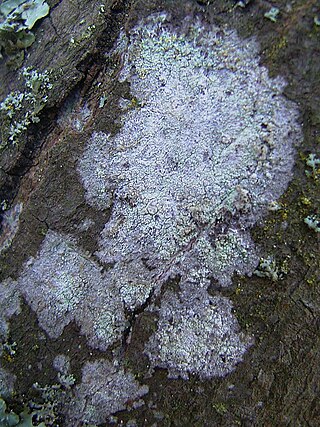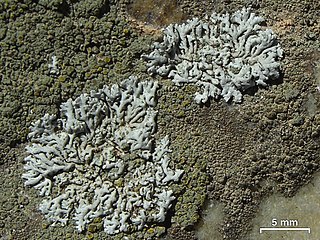
An epiphyte is an organism that grows on the surface of a plant and derives its moisture and nutrients from the air, rain, water or from debris accumulating around it. The plants on which epiphytes grow are called phorophytes. Epiphytes take part in nutrient cycles and add to both the diversity and biomass of the ecosystem in which they occur, like any other organism. They are an important source of food for many species. Typically, the older parts of a plant will have more epiphytes growing on them. Epiphytes differ from parasites in that they grow on other plants for physical support and do not necessarily affect the host negatively. An organism that grows on another organism that is not a plant may be called an epibiont. Epiphytes are usually found in the temperate zone or in the tropics. Epiphyte species make good houseplants due to their minimal water and soil requirements. Epiphytes provide a rich and diverse habitat for other organisms including animals, fungi, bacteria, and myxomycetes.

A lichen is a composite organism that arises from algae or cyanobacteria living among filaments of multiple fungi species in a mutualistic relationship. Lichens are important actors in nutrient cycling and act as the producers for which many higher trophic feeders feed off of, such as reindeer, gastropods, nematodes, mites, and springtails. Lichens have properties different from those of their component organisms. They come in many colors, sizes, and forms and are sometimes plant-like, but are not plants. They may have tiny, leafless branches (fruticose); flat leaf-like structures (foliose); grow crust-like, adhering tightly to a surface (substrate) like a thick coat of paint (crustose); have a powder-like appearance (leprose); or other growth forms.

The Cladoniaceae are a family of lichenized fungi in the order Lecanorales. It is one of the largest families of lichen-forming fungi, with about 560 species distributed amongst 17 genera. The reindeer moss and cup lichens (Cladonia) belong to this family. The latter genus, which comprises about 500 species, forms a major part of the diet of large mammals in taiga and tundra ecosystems. Many Cladoniaceae lichens grow on soil, but other can use decaying wood, tree trunks, and, in a few instances, rocks as their substrate. They grow in places with high humidity, and cannot tolerate aridity.

A prothallus, or prothallium, is usually the gametophyte stage in the life of a fern or other pteridophyte. Occasionally the term is also used to describe the young gametophyte of a liverwort or peat moss as well. In lichens it refers to the region of the thallus that is free of algae.

Crustose is a habit of some types of algae and lichens in which the organism grows tightly appressed to a substrate, forming a biological layer. Crustose adheres very closely to the substrates at all points. Crustose is found on rocks and tree bark. Some species of marine algae of the Rhodophyta, in particular members of the order Corallinales, family Corallinaceae, subfamily Melobesioideae with cell walls containing calcium carbonate grow to great depths in the intertidal zone, forming crusts on various substrates. The substrate can be rocks throughout the intertidal zone, or, as in the case of the Corallinales, reef-building corals, and other living organisms including plants, such as mangroves and animals such as shelled molluscs. The coralline red algae are major members of coral reef communities, cementing the corals together with their crusts. Among the brown algae, the order Ralfsiales comprises two families of crustose algae.

Phlyctis is a genus of lichenized fungi in the order Gyalectales, and the type genus of the family Phlyctidaceae. Members of the genus are commonly called blemished lichens.
Lichens of the Sierra Nevada have been little studied. A lichen is a composite organism consisting of a fungus and a photosynthetic partner growing together in a symbiotic relationship.

Crustose lichens are lichens that form a crust which strongly adheres to the substrate, making separation from the substrate impossible without destruction. The basic structure of crustose lichens consists of a cortex layer, an algal layer, and a medulla. The upper cortex layer is differentiated and is usually pigmented. The algal layer lies beneath the cortex. The medulla fastens the lichen to the substrate and is made up of fungal hyphae. The surface of crustose lichens is characterized by branching cracks that periodically close in response to climatic variations such as alternate wetting and drying regimes.

Lichens are symbiotic organisms made up of multiple species: a fungus, one or more photobionts and sometimes a yeast. They are regularly grouped by their external appearance – a characteristic known as their growth form. This form, which is based on the appearance of vegetative part of the lichen, varies depending on the species and the environmental conditions it faces. Lichenologists have described a dozen of these forms: areolate, byssoid, calicioid, cladoniform, crustose, filamentous, foliose, fruticose, gelatinous, leprose, placoidioid and squamulose. Traditionally, crustose (flat), foliose (leafy) and fruticose (shrubby) are considered to be the three main forms. In addition to these more formalised, traditional growth types, there are a handful of informal types named for their resemblance to the lichens of specific genera. These include alectorioid, catapyrenioid, cetrarioid, hypogymnioid, parmelioid and usneoid.

Haematomma ochroleucum, also known as yellow bloodstain lichen, is a species of crustose lichenized fungus. First described in 1771 by Noël Martin Joseph de Necker, it has no subspecies, but two named varieties: H. o. var. ochroleucum and H. o. var. porphyrium.

Candelariella antennaria, or the pussytoes eggyolk lichen, is a lichen commonly distributed in North America, and has been observed in South America, Asia, Australia, and Europe. It is characterized by its gray thallus and bright yellow apothecia, as well as its very small size.

Punctelia borreri is a species of foliose lichen in the family Parmeliaceae. It is a common and widely distributed species, occurring in tropical, subtropical, and temperate regions of Africa, Asia, Europe, North America, Oceania, and South America. The lichen typically grows on bark of deciduous trees, and less commonly on rock. Some European countries have reported increases in the geographic range or regional frequency of the lichen in recent decades, attributed alternatively to a reduction of atmospheric sulphur dioxide levels or an increase in temperatures resulting from climate change.
Lecanora hafelliana is a species of corticolous (bark-dwelling), crustose lichen in the family Lecanoraceae. It is found in South Korea and in China, where it is fairly common on the bark of deciduous trees such as maple, birch, dogwood, and oak. The lichen was formally described as a new species in 2011 by Lei Lü, Yogesh Joshi, and Jae-Seoun Hur. The type specimen was collected by Hur on Mount Baekwoon at an elevation of 1,037 m (3,402 ft). In China, it was recorded growing on the bark of Korean pine. The lichen has a dull whitish to ash-grey crust-like thallus with a definite margin, but lacking a prothallus. Lecanora hafelliana contains several secondary compounds, including atranorin, zeorin, usnic acid, a complex of compounds related to stictic acid, and hafellic acid. Its specific epithet alludes to the presence of this latter compound.
Loxospora cristinae is a fungal species classified in 2018, found in a few European countries. It belongs to the division Ascomycota and the family Sarrameanaceae. It was first identified and described in the 19th century, but the species would not be correctly classified until almost two centuries later. Loxospora cristinae is a sterile crustose lichen, meaning it reproduces by a type of vegetative spore that has evolved specifically to produce morphological structures.
Inoderma sorediatum is a species of crustose lichen in the family Arthoniaceae. It is only known to occur on the bark of trees in Poland's Białowieża National Park. It is differentiated from other species in genus Inoderma by the form of its thallus, which is entirely made of powdery, granular soredia, as well as by the presence of a unique combination of lichen products.
Lecidella mandshurica is a species of corticolous (bark-dwelling), crustose lichen in the family Lecanoraceae. It is found in the Russian Far East, South Korea, and China.
Biatora oxneri is a species of corticolous (bark-dwelling) lichen in the family Ramalinaceae. It is found in the Russian Far East and in South Korea.

Lecanora confusa is a species of corticolous (bark-dwelling), crustose lichen in the family Lecanoraceae. It was described as new to science in 1955 by Swedish lichenologist Ove Almborn. It is a member of the species complex resembling Lecanora polytropa.
Coenogonium lueckingii is a species of corticolous (bark-dwelling), crustose lichen in the family Coenogoniaceae. It is known to occur in a couple of locations in South Korea, where it grows on the bark of trees in humid locations.












